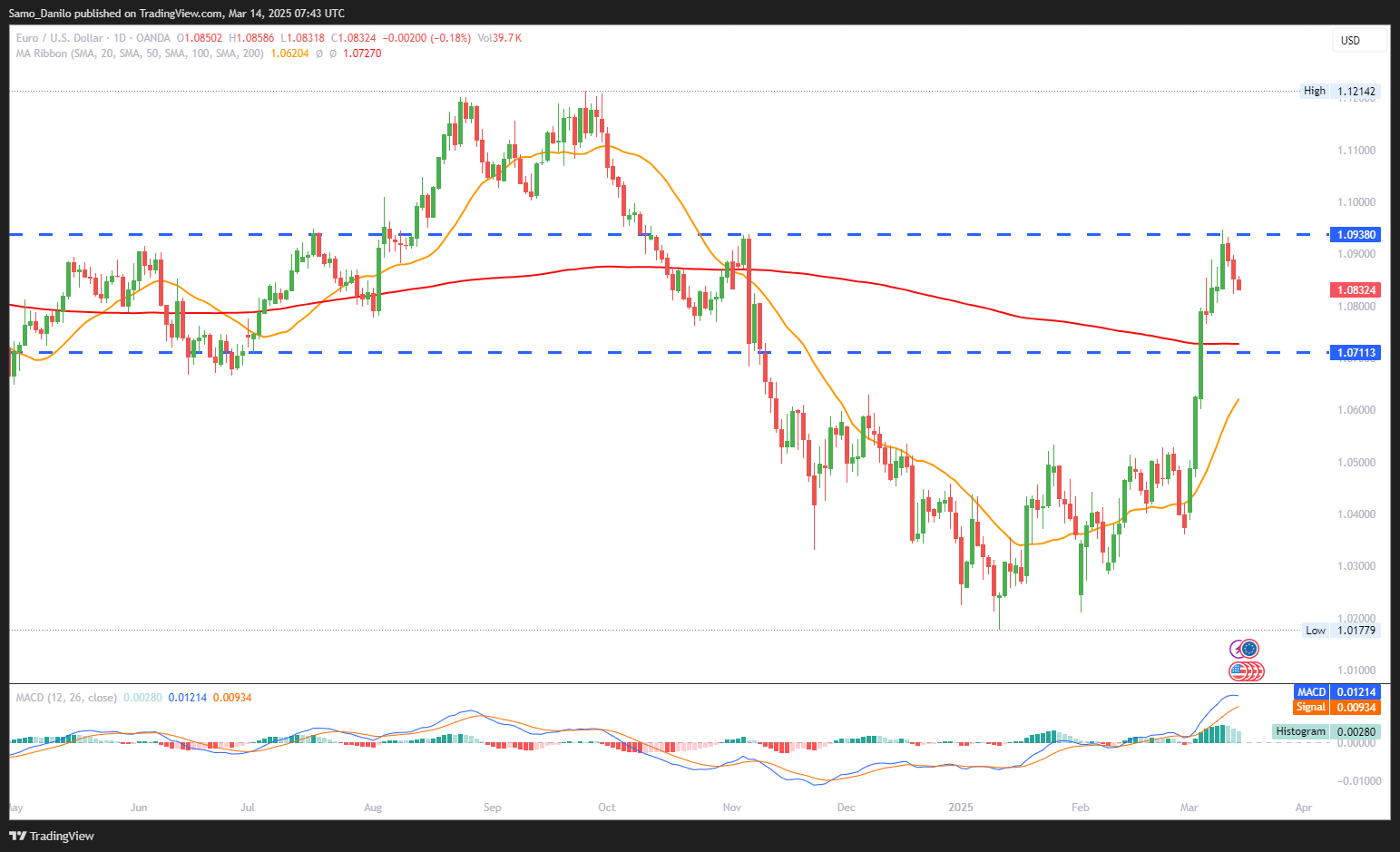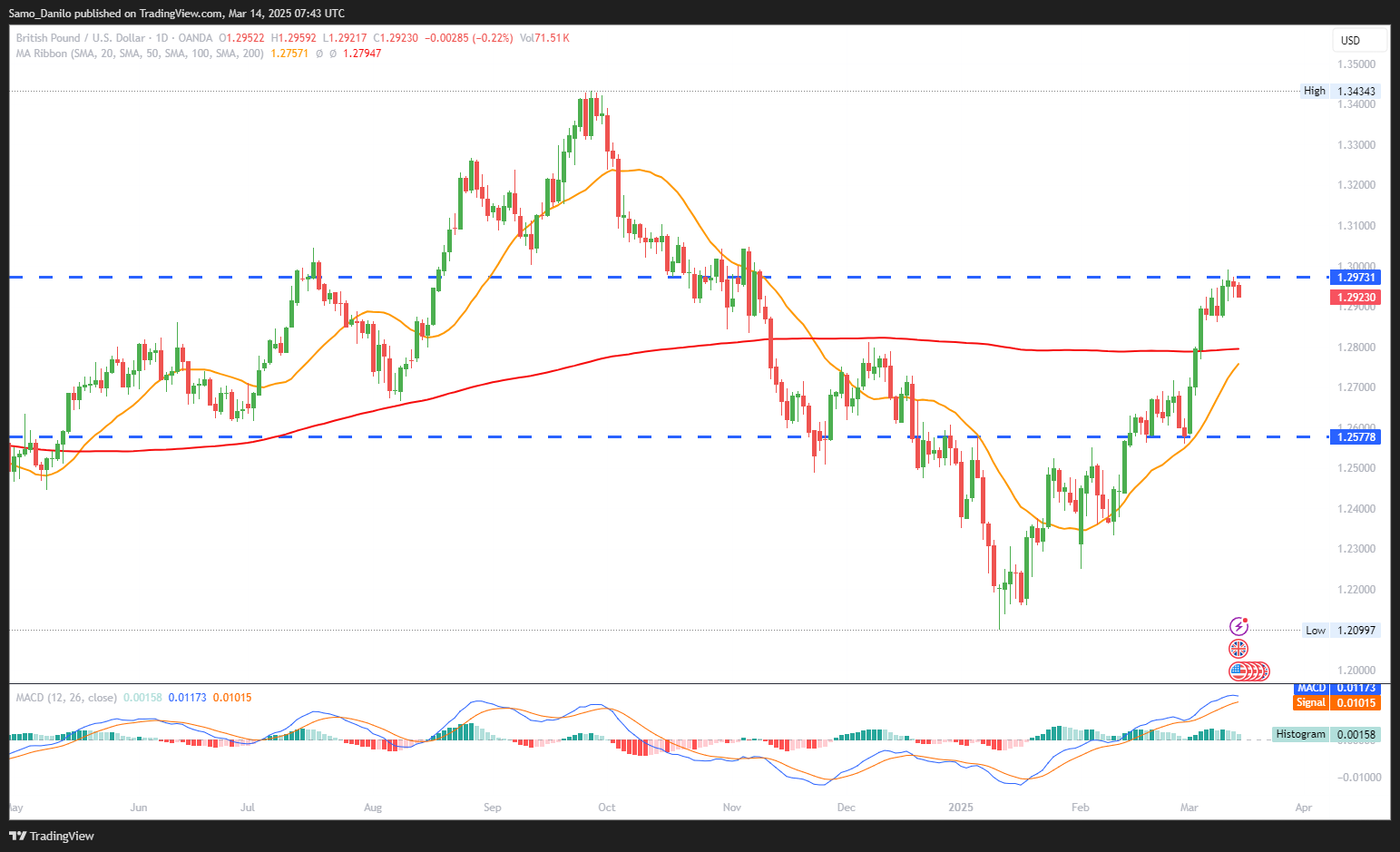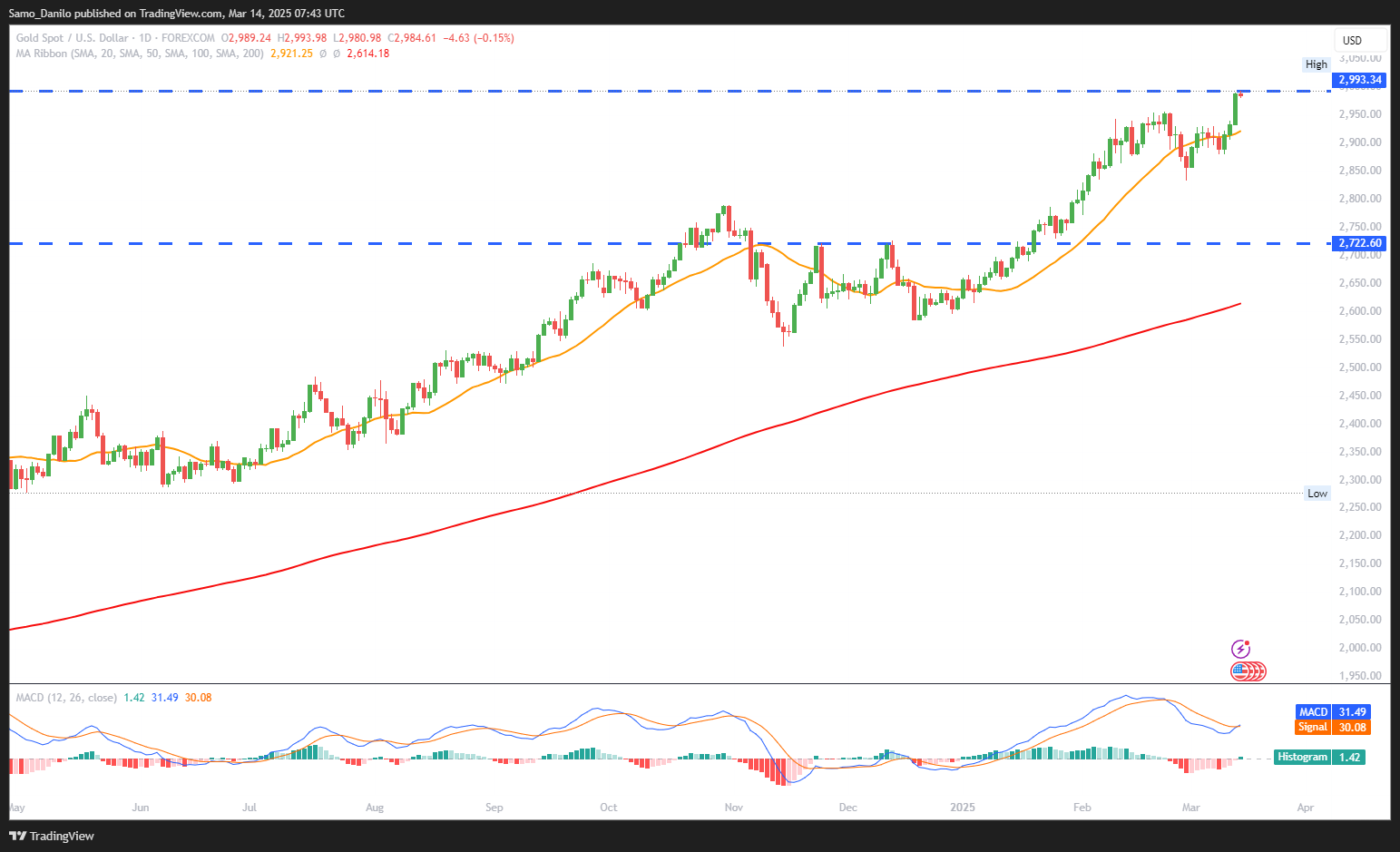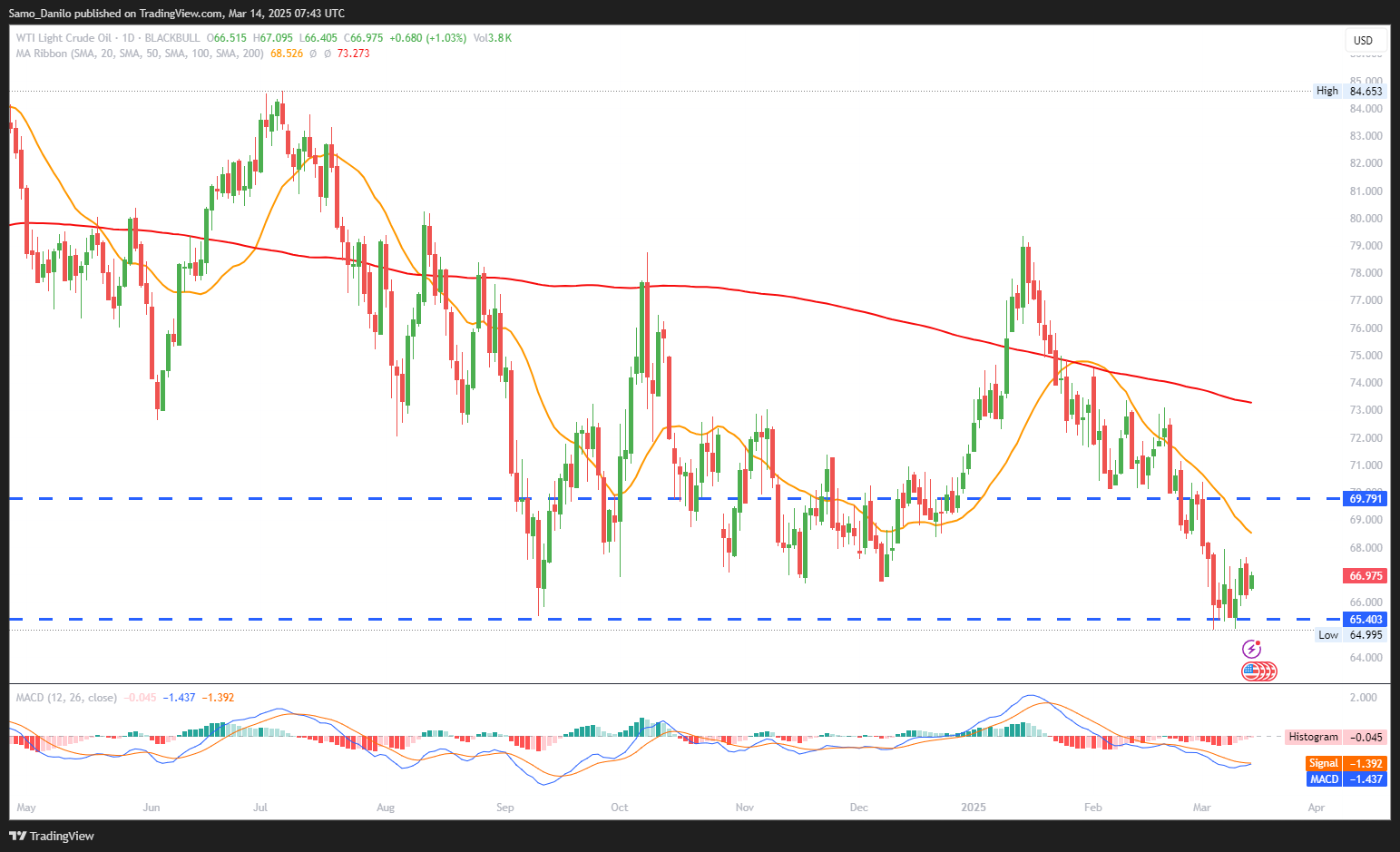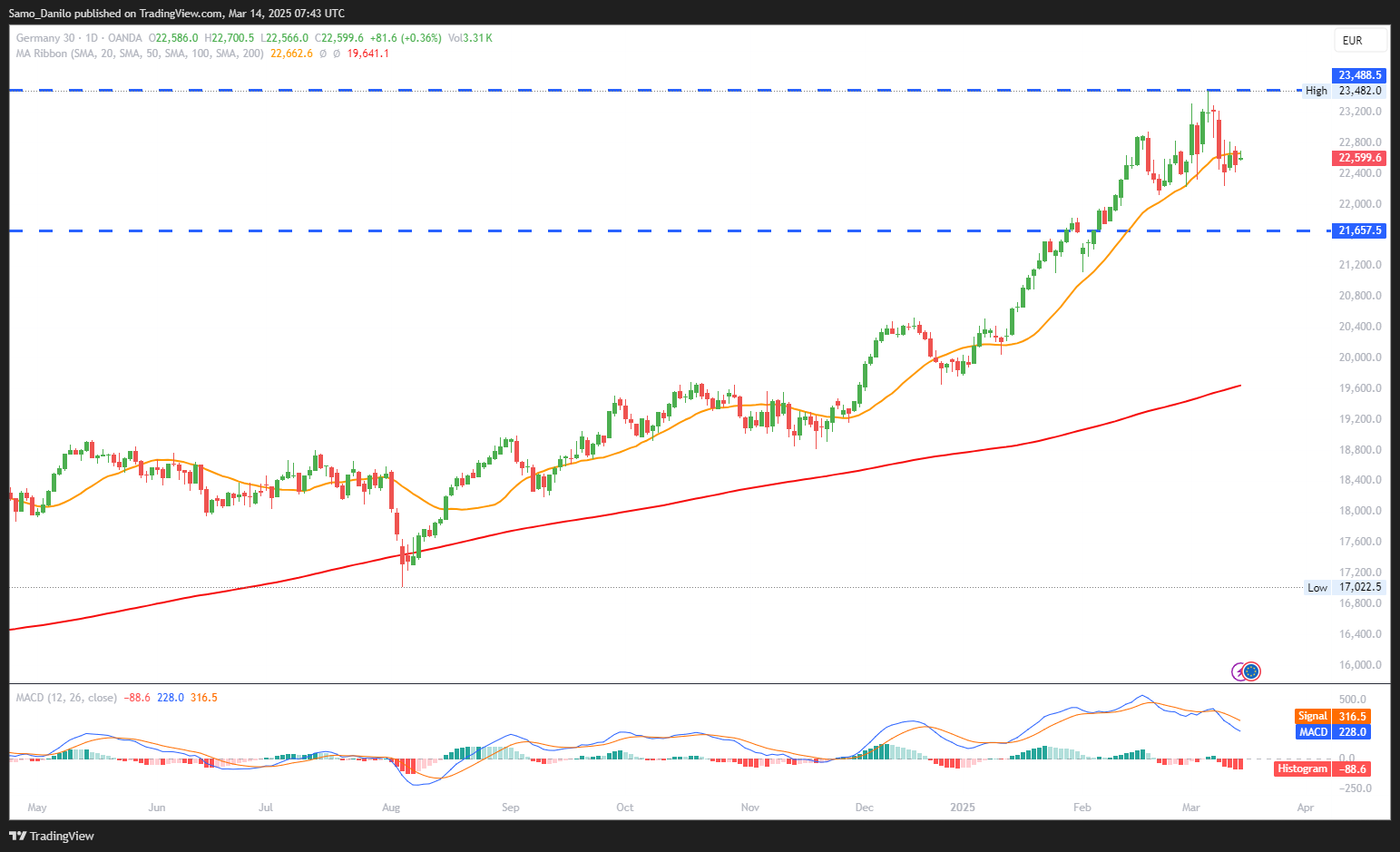EURUSD
- EUR/USD Price: The EUR/USD pair edged lower to around 1.0835 during Friday's European session, as escalating trade tensions between the US and EU weighed on the Euro.
- New Trump Tariffs: Late Thursday, President Trump threatened to impose a 200% tariff on wine, cognac, and other European alcohol imports. This followed the EU's plan to impose tariffs on American whiskey and other products in April, in response to Trump’s 25% duties on steel and aluminum imposed on Wednesday.
- ECB Official: Bundesbank President Joachim Nagel cautioned that US tariffs on imported goods could push Germany—Europe’s largest economy—into a recession, worsening the already fragile economic outlook.
- Fed Rate Cut Forecast: Barclays adjusted its forecast for the Federal Reserve's policy path, now expecting two 25-basis-point cuts in June and September, which could weigh on the Dollar in the medium term.
- Russia-Ukraine Talks: Positive signs around Russia-Ukraine peace negotiations could provide modest support to the Euro, easing geopolitical pressures in the region.
Closing statement: EUR/USD faces near-term downside risks from US-EU trade conflicts and recession fears in Germany. However, potential Fed rate cuts and progress on geopolitical issues could stabilize the pair in the coming months.
GBPUSD
- GBP/USD Price: The GBP/USD pair lost momentum during Friday’s European session, sliding toward 1.2900 as weak UK economic data weighed on the Pound.
- UK Economic Data: UK Gross Domestic Product (GDP) contracted by 0.1% in January on a monthly basis, while Manufacturing Production fell by 1.1%, highlighting economic weakness and adding pressure on the Pound.
- US Inflation: US Producer Price Index (PPI) rose 3.2% year-over-year in February, down from 3.7% in January and below the 3.3% market forecast, reinforcing expectations of a softer inflation outlook.
- US Job Market: US Initial Jobless Claims for the week ending March 7 came in at 220,000, better than the expected 225,000, indicating resilience in the US labor market and supporting the Dollar.
- US Consumer Sentiment: Traders are eyeing the Michigan Consumer Sentiment Index data due later on Friday, which could influence market expectations for the Federal Reserve’s rate-cut path.
Closing statement: GBP/USD faces downside pressure from weak UK growth and strong US labor data. Softer US inflation may limit Dollar gains, but near-term sentiment remains cautious ahead of US consumer sentiment data.
XAUUSD
- XAU/USD Price: Gold price remains close to the $3,000 mark, consolidating near record highs. The yellow metal is set to post a 2.5% weekly gain amid heightened trade tensions and geopolitical uncertainties.
- US Inflation Data: The US Producer Price Index (PPI) was unchanged in February, with the yearly rate slowing to 3.2% from 3.7% in January. Signs of easing inflationary pressure support expectations for potential Federal Reserve rate cuts.
- Canada-US Trade Talks: Ontario Premier Doug Ford confirmed another meeting next week between Canadian and US trade officials, following discussions with US Commerce Secretary Howard Lutnick on resolving trade disputes.
- Ceasefire Talks: Russian President Vladimir Putin stated on Thursday that he agreed in principle with US proposals to halt the Ukraine conflict but emphasized the need to address the “root causes.” This geopolitical development adds to market uncertainty.
- US Data: Markets are awaiting the US Consumer Sentiment and Inflation Expectations data, but tariff and geopolitical headlines are expected to dominate sentiment heading into the weekend.
Closing statement: Gold remains well-supported near record highs as trade tensions and geopolitical risks fuel safe-haven demand. Softer US inflation data could reinforce expectations for Fed easing, supporting further upside.
CRUDE OIL
- Crude Oil Price: West Texas Intermediate (WTI) edged higher on Friday, trading around $67.00 per barrel after losing over 1% on Thursday. However, it remains on track for its eighth straight weekly decline, highlighting ongoing bearish pressure.
- Iran's Oil Sector: The US imposed new sanctions on Iran’s Oil Minister and Hong Kong-flagged vessels involved in Iran’s "shadow fleet" on Thursday as part of its "maximum pressure" campaign. This move could tighten supply but failed to lift prices meaningfully.
- Ceasefire Proposal: EU High Representative Kaja Kallas indicated that Russia might accept the US-backed ceasefire proposal with certain conditions, offering some relief to geopolitical tensions that have weighed on oil prices.
- Trade War Fears: Global demand concerns persist after President Trump threatened a 200% tariff on European wine and champagne on Thursday, raising fears of escalating trade tensions and weaker economic growth.
- Growing Supply Surplus: The International Energy Agency (IEA) warned that a growing supply surplus could pressure prices further as OPEC+ ramps up production amid slowing global demand tied to trade tensions.
Closing statement: WTI faces mixed signals, with geopolitical tensions and supply risks supporting prices, while weak demand and trade uncertainty weigh on sentiment. A decisive break above $68.00 could signal short-term recovery.
DAX
- DAX Price: The DAX fell 0.48% on Thursday, closing at 22,676, partially reversing Wednesday’s 1.56% rally. Risk aversion increased as US-EU trade tensions intensified, weighing on market sentiment.
- German Inflation: Germany’s Consumer Price Index (CPI) remained at +2.3% year-over-year in February 2025, unchanged from January. Stable inflation suggests limited pressure on the European Central Bank (ECB) to adjust policy.
- Wholesale Prices: Wholesale selling prices in Germany rose 1.6% year-over-year in February 2025, up from +0.9% in January and +0.1% in December, indicating a gradual build-up of cost pressures in the supply chain.
- Fiscal Policy: German Greens Party official Hasselman reported no progress in debt plan negotiations with Conservatives/SPD on March 13, highlighting ongoing political gridlock on fiscal policy.
- US Consumer Sentiment: The Michigan Consumer Sentiment Index (due Friday, March 14) is expected to fall from 64.7 in February to 63.1 in March. A weaker reading could weigh further on global risk sentiment.
Closing statement: The DAX faces headwinds from political uncertainty and trade tensions. A drop below 22,500 could signal further downside, while stable inflation may provide limited support.
